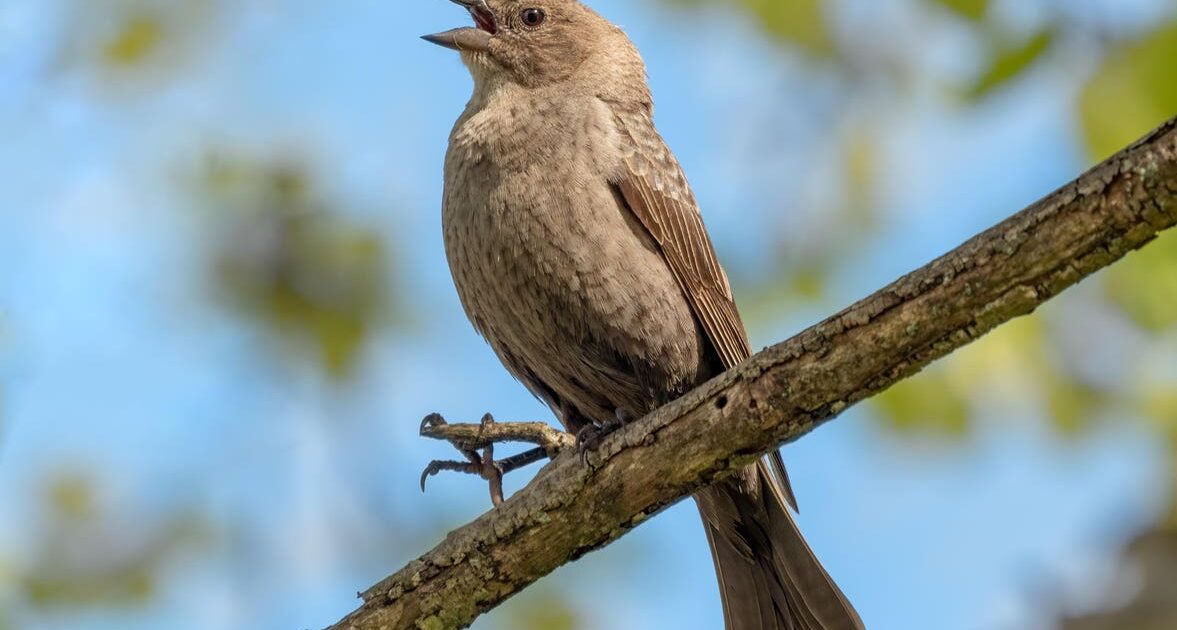Young Cowbirds Look To Adult Females For Proper Social Development

Raised by foster parents, how do juvenile cowbirds discover their true identity and learn proper social development so they grow up to be normally functioning adult cowbirds?
Female brown-headed cowbird (Molothrus ater) singing at Jamaica Bay Wildlife Refuge, New York. (Credit: Rhododendrites / CC BY-SA 4.0)
Rhododendrites via a Creative Commons license
Most birders don’t much like cowbirds because the adults lay their eggs in other songbirds’ nests and abandon them to be raised by their foster parents, often at the expense of the foster parents’ own offspring. This life history trait is known as obligate brood parasitism.
“Cowbirds often get a bad rap because they’re brood parasites,” the study’s lead author, behavioral ecologist Mac Chamberlain, a PhD Candidate at the University of Illinois Urbana-Champaign, told me in email.
“But it’s exactly this unusual start in life that has pushed them to evolve some remarkably creative strategies to navigate the world,” Mr Chamberlain explained in email. “Less than 1% of all bird species in the world are brood parasites, with cowbirds being the only obligate brood parasite bird group in North America. Rather than seeing them as villains, we should start recognizing cowbirds as a powerful example of how nature comes up with clever and unexpected ways to solve tough problems.”
Upon hatching, most young birds imprint on the first moving being they see and view that particular being as their parent. So how do juvenile Brown-headed Cowbirds, Molothrus ater, who probably have never seen their parents, discover their true identity and learn proper social development so they grow up to be normally functioning adult cowbirds?
A recent study led by Mr Chamberlain finds that fledgling cowbirds specifically seek out and follow adult female cowbirds. These adult females appear to be mentoring the juveniles in the complex social art of being a proper cowbird, acting as role models for how to find food, proper mating behaviors, and how to protect themselves from predators so they can join the adult flock.
A group of three male and one female (lower right) cowbirds (Molothrus ater). (Credit: Patricia Pierce / CC BY 2.0)
Patricia Pierce via a Creative Commons license
But what is it about adult female cowbirds that is so attractive to these juveniles? First, female cowbirds’ plumage is more similar in appearance to the juveniles than to that of the more aggressive male cowbirds, which probably partially explains why the young birds seek them out. In addition to similarities in appearance, the young cowbirds are drawn to the chattering noises of adult female cowbirds (read more here).
“All cowbirds hatch with a built-in attraction to the female ‘chatter’ call,” Mr Chamberlain told me in email. “This call acts like a homing beacon, helping the juvenile cowbirds find others of the same species. Even without learning it, they recognize that sound as something familiar. Lab-raised cowbirds also tend to gravitate toward birds that look like them. Lastly, as the young cowbirds grow up and begin to resemble adults, other bird species will start showing more aggression towards them. Between the sound, the visual cues, and the social pressure they receive from different species, young cowbirds are highly motivated to seek out the safety and familiarity of their own kind.”
The study suggests that the young cowbirds may be specifically seeking out adult cowbirds with female characteristics with no preference, or perhaps no knowledge, of whether they are related.
“What surprised me was how clearly the juveniles in the wild showed a preference for adult females,” Mr Chamberlain said in email. “This lines up with what lab studies have suggested, but with only seven juvenile birds in our sample, I didn’t expect the pattern to be so strong. It’s uncommon to see such a clear signal in the wild with such a small group, which makes the result all the more exciting.”
How did the team figure out that juvenile cowbirds are attracted to adult females of the species? Over a period of three years, they captured 122 cowbirds in total and used DNA testing to identify both the sex of captured juveniles and to determine whether the captured adult-juvenile pairs were related to each other. In fact, they found that only 2 of the 7 juvenile cowbirds were captured along with a relative. Despite the fact that the population is comprised mostly of adult males, the juvenile cowbirds were much more likely to be captured in the company of adult females.
These results suggest that the young cowbirds may be specifically seeking out adult cowbirds with female characteristics with no preference, or perhaps no knowledge, of whether they are related.
This study’s findings are contrary to earlier findings which indicated that captured adult-juvenile pairs were likely to be related. That said, the sample was very small and did not include all potential parents in the population, so it must be replicated with much larger numbers to determine whether relatedness plays any role in the social development of cowbirds.
Are there plans to follow up, or perhaps to study juvenile cowbirds’ social interactions with adult males?
“At the moment, we don’t have plans to continue this work, but it’s a question that definitely deserves more attention,” Mr Chamberlain replied in email. “Juvenile cowbirds likely continue to learn and refine their social behavior well into the fall and through their first breeding season. Understanding how they interact with adult males during that period could fill in some big gaps. Tracking specific individuals across those critical stages would help us see how early experiences shape their social development and how those relationships unfold over time.”
Source:
Mac L. Chamberlain, Wendy Schelsky, Autumn Bush, Shanelle Johnson-Cadle, Shelby Lawson, and Mark E. Hauber (2025). Adult sex dictates juvenile-adult interactions in brood-parasitic brown-headed cowbirds, Molothrus ater, Animal Behaviour, 226:123247 | doi:10.1016/j.anbehav.2025.123247
© Copyright by GrrlScientist | hosted by Forbes | LinkTr.ee
Socials: Bluesky | CounterSocial | Gab | LinkedIn | Mastodon Science | Spoutible | SubStack | Threads | Tribel | Tumblr | Twitter

